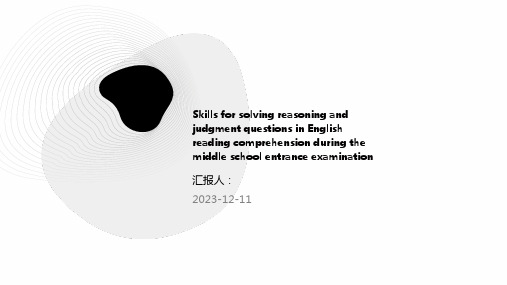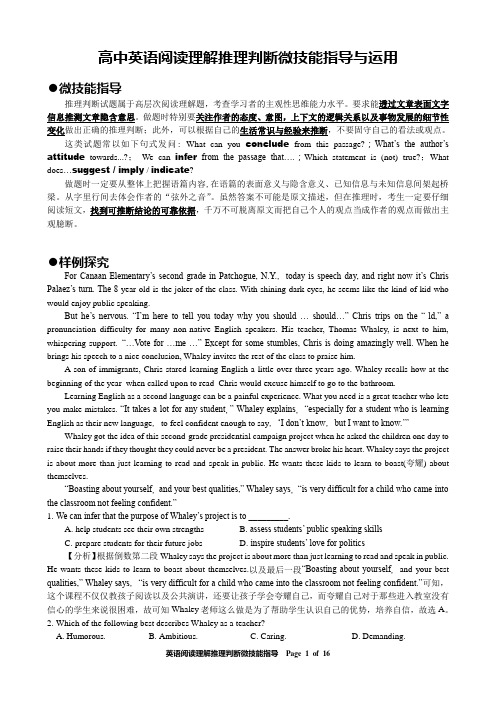Reading Skills Ⅲ推理判断
- 格式:ppt
- 大小:951.00 KB
- 文档页数:28




高中英语阅读理解推理判断微技能指导与运用●微技能指导推理判断试题属于高层次阅读理解题,考查学习者的主观性思维能力水平。
要求能透过文章表面文字信息推测文章隐含意思。
做题时特别要关注作者的态度、意图,上下文的逻辑关系以及事物发展的细节性变化做出正确的推理判断;此外,可以根据自己的生活常识与经验来推断,不要固守自己的看法或观点。
这类试题常以如下句式发问:What can you conclude from this passage?;What’s the author’s attitude towards...?;We can infer from the passage that….;Which statement is (not) true?;What does…suggest / imply / indicate?做题时一定要从整体上把握语篇内容,在语篇的表面意义与隐含意义、已知信息与未知信息间架起桥梁。
从字里行间去体会作者的“弦外之音”。
虽然答案不可能是原文描述,但在推理时,考生一定要仔细阅读短文,找到可推断结论的可靠依据,千万不可脱离原文而把自己个人的观点当成作者的观点而做出主观臆断。
●样例探究For Canaan Elementary’s second grade in Patchogue, N.Y., today is speech day, and right now it’s Chris Palaez’s turn. The 8-year-old is the joker of the class. With shining dark eyes, he seems like the kind of kid who would enjoy public speaking.But he’s nervous. “I’m here to tell you today why you should … should…” Chris trips on the “-ld,” a pronunciation difficulty for many non-native English speakers. His teacher, Thomas Whaley, is next to him, whispering support.“…V ote for …me …” Except for some stumbles, Chris is doing amazingly well. When he brings his speech to a nice conclusion, Whaley invites the rest of the class to praise him.A son of immigrants, Chris stared learning English a little over three years ago. Whaley recalls how at the beginning of the year when called upon to read Chris would excuse himself to go to the bathroom.Learning English as a second language can be a painful experience. What you need is a great teacher who lets you make mistakes. “It takes a lot for any student,” Whaley explains, “especially for a student who is learning English as their new language, to feel confident enough to say, ‘I don’t know, but I want to know.’”Whaley got the idea of this second-grade presidential campaign project when he asked the children one day to raise their hands if they thought they could never be a president. The answer broke his heart. Whaley says the project is about more than just learning to read and speak in public. He wants these kids to learn to boast(夸耀) about themselves.“Boasting about yourself, and your best qualities,” Whaley says, “is very difficult for a child who came into the classroom not feeling confident.”1. We can infer that the purpose of Whaley’s project is to _________.A. help students see their own strengthsB. assess students’ public speaking skillsC. prepare students for their future jobsD. inspire students’ love for politics【分析】根据倒数第二段Whaley says the project is about more than just learning to read and speak in public. He wants these kids to learn to boast about themselves.以及最后一段“Boasting about yourself, and your best qualities,” Whaley says, “is very difficult for a child who came into the classroom not feeling confident.”可知,这个课程不仅仅教孩子阅读以及公共演讲,还要让孩子学会夸耀自己,而夸耀自己对于那些进入教室没有信心的学生来说很困难,故可知Whaley老师这么做是为了帮助学生认识自己的优势,培养自信,故选A。

推理判断题英语阅读Nowadays, being able to think critically and make accurate judgments is an essential skill in our daily lives. This is especially true when it comes to reading comprehension, as we often encounter various inference and reasoning questions. In this article, we will explore strategies for tackling these types of questions effectively.1. Understanding the PassageBefore attempting any inference or reasoning questions, it is crucial to have a thorough understanding of the passage. Read the passage carefully and take note of the main ideas, supporting details, and the overall tone. By having a solid grasp of the passage's content, you will be better equipped to answer inference questions accurately.2. Identify the ContextWhen encountering an inference or reasoning question, it is vital to identify the context in which the question is being asked. Look for clues within the passage that can help you determine the intended meaning. Pay attention to signal words, such as "suggest," "imply," or "infer," as they often indicate that an inference is required.3. Use Prior KnowledgeDrawing upon your prior knowledge can greatly aid in making accurate inferences. Relate the information presented in the passage to your own experiences and background knowledge. However, be cautious not to relytoo heavily on personal beliefs or assumptions. It is essential to base your inferences on the information provided in the passage.4. Analyze RelationshipsOne effective strategy for answering inference questions is to analyze the relationships between different pieces of information in the passage. Look for cause-and-effect relationships, comparisons, or contradictions that can provide insights into the correct answer. By examining these relationships, you can infer the most logical and supported conclusion.5. Consider Multiple PerspectivesIn some cases, passages may present conflicting viewpoints or include ambiguous information. When faced with such situations, it is important to consider multiple perspectives. Evaluate the different arguments or viewpoints presented in the passage and choose the one that best aligns with the given information. Avoid making assumptions or jumping to conclusions without sufficient evidence.6. Pay Attention to LanguageCarefully analyze the language used in the passage, as it can provide valuable clues for making accurate inferences. Look for strong or exaggerated words that indicate the author's opinion or bias. Similarly, pay attention to the tone of the passage, as it can help you infer the author's attitude or intention.7. Eliminate False ChoicesWhen answering inference questions, it can be helpful to eliminate false choices. Identify options that are not supported by the information provided in the passage and eliminate them from consideration. This can increase your chances of selecting the correct answer.In conclusion, being able to tackle inference and reasoning questions effectively is an important skill for English reading comprehension. By understanding the passage, identifying the context, using prior knowledge, analyzing relationships, considering multiple perspectives, paying attention to language, and eliminating false choices, we can enhance our ability to make accurate judgments and answer inference questions successfully. Remember to practice these strategies regularly to improve your overall reading comprehension skills.。

英语6级知识点归纳总结英语6级考试,也称为大学英语六级考试(College English Test, CET-6),是中国教育部主管的一项国家级英语水平考试。
它评估考生对英语听说读写能力的掌握程度,是中国大学本科生英语水平的重要标准之一。
本文将对英语6级考试中的主要知识点进行归纳总结,帮助考生备考和复习。
一、阅读理解(Reading Comprehension)1. 主旨大意题(Main Idea):需要根据文章的整体内容和结构,确定文章的主旨或中心思想。
2. 细节事实题(Detail):针对文章中的具体信息提问,需要根据文章中的细节信息进行判断。
3. 推理判断题(Inference):要求根据已有信息进行推理判断,填补文章中的信息空缺。
4. 作者观点题(Author's Attitude):需要根据文章中的措辞和语气判断出作者的态度和观点。
5. 结构组织题(Organization):需要理解文章的逻辑结构、段落结构和篇章结构。
二、完形填空(Cloze)1. 词汇辨析题(Vocabulary):根据上下文推断词义,考察词汇的灵活运用能力。
2. 语法填空题(Grammar):要求根据上下文语境,在空格处填入适当的词或短语,考察语法知识的掌握程度。
3. 逻辑填空题(Logic):需要根据文章的逻辑关系,填入合适的内容,考察对文章的整体理解能力。
三、听力理解(Listening Comprehension)1. 听力选择题(Multiple Choice):根据听到的对话或独白内容,选择正确的答案。
2. 听力填空题(Cloze):听到对话或独白中缺失的信息,填写在题目给出的空格中。
3. 听力判断题(True/False):根据听到的对话或独白内容,判断给出的句子是否与所听到的内容相符。
四、写作(Writing)1. 命题作文(Argumentative Essay):根据提供的题目或文章,展开论述,表达自己的观点和看法。
初中英语阅读技巧之推理判断英语阅读是学习英语的重要环节之一,而推理判断是阅读中的一种重要技巧。
通过推理判断,我们可以根据文章中的线索和信息,进行合理的推断和判断。
下面将从几个方面介绍初中英语阅读中的推理判断技巧。
首先,正确理解文章主旨是进行推理判断的基础。
在阅读一篇文章之前,我们应该先读一下文章的标题和开头段落,这样可以帮助我们快速了解文章的主题和大意。
然后,我们可以通过仔细阅读每个段落,寻找关键词和关键句子,来推断出文章的主旨。
例如,如果一篇文章的标题是“Protecting the Environment”,开头段落提到了“global warming”和“pollution”,那么我们可以推断出这篇文章的主题是关于环境保护的。
其次,理解上下文关系对于推理判断也非常重要。
在阅读过程中,我们经常会遇到一些生词或不熟悉的词语,这时候我们可以通过上下文来推断出它们的意思。
上下文关系包括同义词、反义词、因果关系、比较关系等。
通过理解上下文关系,我们可以更好地理解文章的意思,并进行推理判断。
例如,如果一篇文章中提到“John is a diligent student. He always finishes his homework on time.”,我们可以推断出“diligent”这个词的意思是“勤奋的”。
此外,推理判断还需要我们注意文章中的细节信息。
在阅读过程中,我们应该注意文章中的数字、时间、地点、人物等具体细节,这些细节往往会帮助我们进行推理判断。
例如,如果一篇文章中提到“Last year, the school organized a charity event and raised $5000 for the orphanage”,我们可以推断出这所学校是一个热心公益的学校。
最后,推理判断也需要我们运用自己的常识和逻辑思维。
有时候,文章中并没有明确给出答案,这时候我们需要根据已有的知识和经验来进行推理判断。
试析英语阅读理解的推理判断技巧试析英语阅读理解的推理判断技巧导语:阅读理解是英语学习中重要的一环,而推理判断是阅读理解中的一种常见题型。
本文旨在探讨英语阅读理解中的推理判断技巧,帮助读者提升阅读理解能力。
一、什么是推理判断题在英语阅读理解中,推理判断题要求根据文章中的信息,进行逻辑推理,对问题进行判断。
推理判断题常见于各种考试中,如雅思、托福、四六级等。
通过对文章的深入理解,读者需要根据所给问题,结合文章中的细节、事实和推理,做出正确的判断。
二、推理判断题的解题要点1. 理解文章信息在解答推理判断题之前,首先要对文章进行全面理解。
阅读文章时,需注意主旨、段落结构、事实细节等。
理解文章内容有助于解决后续问题,同时可以减少在可能的错误选项上浪费时间。
2. 掌握推理判断的常见类型推理判断题有多种类型,如因果关系、比较对比、转折关系以及推理结论等。
掌握这些常见类型,有助于正确地解答问题。
例如,在因果关系题中,需要分辨文章中的因果关系,判断其逻辑关系,找出问题的答案。
3. 注意语言词汇的暗示在阅读文章时,需要注意文章中的描写手法和词汇暗示。
有时,作者会使用一些暗示性词汇,如“因此”、“所以”、“然而”等来表示某种逻辑关系,读者可以通过这些关键词来解答问题。
4. 运用逻辑推理推理判断题需要读者在阅读文章的基础上进行逻辑推理。
通过对文章中的信息进行整合,读者可以推断出某些结论或答案。
在此过程中,需要注意保持逻辑的连贯性和合理性。
5. 判断选项的权衡与排除在解答推理判断题时,需要分析选项之间的差异,并进行权衡和排除。
有时,某些选项可能与文章中的信息不符合,或者没有足够的依据进行推理判断。
通过分析选项,可以有效地缩小答案的范围,并选择最合适的选项。
三、推理判断题的解题策略1. 训练阅读速度和理解能力阅读速度和理解能力是解答推理判断题的基础。
通过每日阅读练习,可以提高阅读速度和理解能力,从而更好地把握文章的内容和结构。
FCE阅读评分标准表本文档旨在介绍FCE(剑桥英语第一级别)阅读评分标准表。
FCE阅读测试是评估学生在理解英语文本方面的能力,考察其对书面材料的理解和分析能力。
考生需要阅读一系列文章,然后回答相关问题。
根据他们对文章内容的理解和对问题的回答能力,评分将在下列标准基础上进行。
评分标准在评分过程中,考官将根据以下标准对考生的阅读能力进行评估:1.理解主要思想(Main Idea):考生是否能够准确理解文章的主要思想和观点。
学生需要能够抓住文章的中心思想,并能够通过问题回答来证明他们的理解。
2.理解细节(Detail):考生是否能够理解文章中的细节并回答与之相关的问题。
学生需要能够从文章中找到关键信息并回答问题。
3.推理和推断(Inference):考生是否能够根据文章内容进行推理和推断。
学生需要能够通过推断来回答与文章逻辑相关的问题。
4.词汇理解(Vocabulary):考生是否能够理解文章中的生词并正确使用。
学生需要通过上下文理解生词的意思,并能够正确使用这些生词。
5.读取技巧(Reading Skills):考生是否能够应用不同的阅读技巧,如快速阅读,扫描和略读。
学生需要能够根据问题的要求采用合适的阅读技巧。
6.连贯性与结构(Coherence and Structure):考生是否能够理解文章的结构和连贯性。
学生需要能够理解文章的段落结构,并将其与问题回答相联系。
评分等级根据上述评分标准,FCE阅读测试的评分等级如下:•分级等级:Grade A–阅读明确且准确,理解文章的主题和细节;–能够推理和推断,理解文章的隐含意思;–词汇掌握广泛,能够正确运用生词;–具有出色的阅读技巧,能够快速找到答案;–逻辑清晰,回答问题准确;–表达清晰,没有语法或拼写错误。
•分级等级:Grade B–阅读大部分明确和准确,能够理解文章的主题和细节;–能够进行一定程度的推理和推断,理解大部分隐含意思;–词汇掌握较好,能够正确使用大部分生词;–具有较好的阅读技巧,能够快速找到答案;–逻辑较为清晰,回答问题基本准确;–表达较为清晰,语法和拼写基本正确。